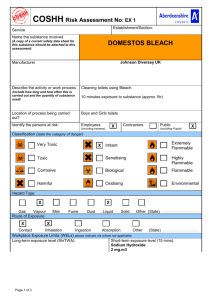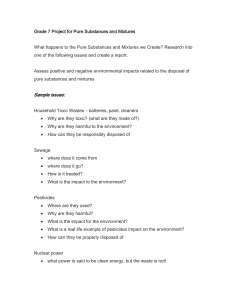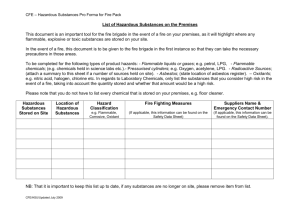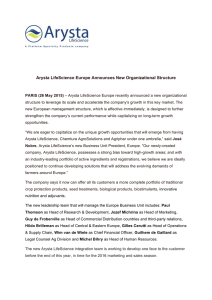Section 1 - Identification of Chemical Product and Company Arysta
advertisement
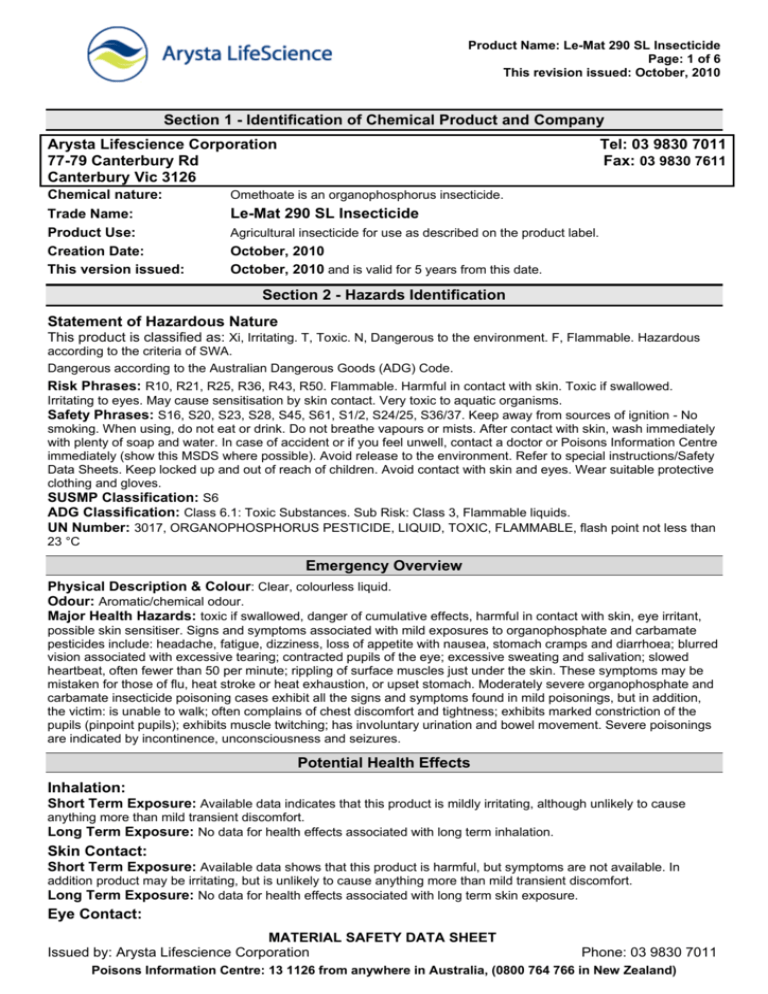
Product Name: Le-Mat 290 SL Insecticide Page: 1 of 6 This revision issued: October, 2010 Section 1 - Identification of Chemical Product and Company Arysta Lifescience Corporation 77-79 Canterbury Rd Canterbury Vic 3126 Tel: 03 9830 7011 Fax: 03 9830 7611 Chemical nature: Omethoate is an organophosphorus insecticide. Trade Name: Product Use: Creation Date: This version issued: Le-Mat 290 SL Insecticide Agricultural insecticide for use as described on the product label. October, 2010 October, 2010 and is valid for 5 years from this date. Section 2 - Hazards Identification Statement of Hazardous Nature This product is classified as: Xi, Irritating. T, Toxic. N, Dangerous to the environment. F, Flammable. Hazardous according to the criteria of SWA. Dangerous according to the Australian Dangerous Goods (ADG) Code. Risk Phrases: R10, R21, R25, R36, R43, R50. Flammable. Harmful in contact with skin. Toxic if swallowed. Irritating to eyes. May cause sensitisation by skin contact. Very toxic to aquatic organisms. Safety Phrases: S16, S20, S23, S28, S45, S61, S1/2, S24/25, S36/37. Keep away from sources of ignition - No smoking. When using, do not eat or drink. Do not breathe vapours or mists. After contact with skin, wash immediately with plenty of soap and water. In case of accident or if you feel unwell, contact a doctor or Poisons Information Centre immediately (show this MSDS where possible). Avoid release to the environment. Refer to special instructions/Safety Data Sheets. Keep locked up and out of reach of children. Avoid contact with skin and eyes. Wear suitable protective clothing and gloves. SUSMP Classification: S6 ADG Classification: Class 6.1: Toxic Substances. Sub Risk: Class 3, Flammable liquids. UN Number: 3017, ORGANOPHOSPHORUS PESTICIDE, LIQUID, TOXIC, FLAMMABLE, flash point not less than 23 °C Emergency Overview Physical Description & Colour: Clear, colourless liquid. Odour: Aromatic/chemical odour. Major Health Hazards: toxic if swallowed, danger of cumulative effects, harmful in contact with skin, eye irritant, possible skin sensitiser. Signs and symptoms associated with mild exposures to organophosphate and carbamate pesticides include: headache, fatigue, dizziness, loss of appetite with nausea, stomach cramps and diarrhoea; blurred vision associated with excessive tearing; contracted pupils of the eye; excessive sweating and salivation; slowed heartbeat, often fewer than 50 per minute; rippling of surface muscles just under the skin. These symptoms may be mistaken for those of flu, heat stroke or heat exhaustion, or upset stomach. Moderately severe organophosphate and carbamate insecticide poisoning cases exhibit all the signs and symptoms found in mild poisonings, but in addition, the victim: is unable to walk; often complains of chest discomfort and tightness; exhibits marked constriction of the pupils (pinpoint pupils); exhibits muscle twitching; has involuntary urination and bowel movement. Severe poisonings are indicated by incontinence, unconsciousness and seizures. Potential Health Effects Inhalation: Short Term Exposure: Available data indicates that this product is mildly irritating, although unlikely to cause anything more than mild transient discomfort. Long Term Exposure: No data for health effects associated with long term inhalation. Skin Contact: Short Term Exposure: Available data shows that this product is harmful, but symptoms are not available. In addition product may be irritating, but is unlikely to cause anything more than mild transient discomfort. Long Term Exposure: No data for health effects associated with long term skin exposure. Eye Contact: MATERIAL SAFETY DATA SHEET Issued by: Arysta Lifescience Corporation Phone: 03 9830 7011 Poisons Information Centre: 13 1126 from anywhere in Australia, (0800 764 766 in New Zealand) Product Name: Le-Mat 290 SL Insecticide Page: 2 of 6 This revision issued: October, 2010 Short Term Exposure: This product is an eye irritant. Symptoms may include stinging and reddening of eyes and watering which may become copious. Other symptoms may also become evident. If exposure is brief, symptoms should disappear once exposure has ceased. However, lengthy exposure or delayed treatment may cause permanent damage. Long Term Exposure: No data for health effects associated with long term eye exposure. Ingestion: Short Term Exposure: Significant oral exposure is considered to be unlikely. Available data shows that this product is toxic, but further symptoms are not available. However, this product is an oral irritant. Symptoms may include burning sensation and reddening of skin in mouth and throat. Other symptoms may also become evident, but all should disappear once exposure has ceased. Long Term Exposure: No data for health effects associated with long term ingestion. Carcinogen Status: SWA: No significant ingredient is classified as carcinogenic by SWA. NTP: No significant ingredient is classified as carcinogenic by NTP. IARC: No significant ingredient is classified as carcinogenic by IARC. Section 3 - Composition/Information on Ingredients Ingredients CAS No Conc,% TWA (mg/m3) STEL (mg/m3) Omethoate 1113-02-6 290g/L not set not set 1-methoxy-2-acetoxypropane 108-65-6 760g/L 274 548 This is a commercial product whose exact ratio of components may vary slightly. Minor quantities of other non hazardous ingredients are also possible. The SWA TWA exposure value is the average airborne concentration of a particular substance when calculated over a normal 8 hour working day for a 5 day working week. The STEL (Short Term Exposure Limit) is an exposure value that may be equalled (but should not be exceeded) for no longer than 15 minutes and should not be repeated more than 4 times per day. There should be at least 60 minutes between successive exposures at the STEL. The term "peak "is used when the TWA limit, because of the rapid action of the substance, should never be exceeded, even briefly. Section 4 - First Aid Measures General Information: You should call The Poisons Information Centre if you feel that you may have been poisoned, burned or irritated by this product. The number is 13 1126 from anywhere in Australia (0800 764 766 in New Zealand) and is available at all times. Have this MSDS with you when you call. If swallowed, splashed on skin or inhaled, contact a Poisons Information Centre or a doctor at once. Remove any contaminated clothing and wash skin thoroughly. Hospital treatment may be necessary. Inhalation: No first aid measures normally required. However, if inhalation has occurred, and irritation has developed, remove to fresh air and observe until recovered. If irritation becomes painful or persists more than about 30 minutes, seek medical advice. Skin Contact: Quickly and gently blot away excess liquid. Wash gently and thoroughly with warm water (use nonabrasive soap if necessary) for 10-20 minutes or until product is removed. Under running water, remove contaminated clothing, shoes and leather goods (e.g. watchbands and belts) and completely decontaminate them before reuse or discard. Eye Contact: Immediately flush the contaminated eye(s) with lukewarm, gently flowing water for 20 minutes or until the product is removed, while holding the eyelid(s) open. Take care not to rinse contaminated water into the unaffected eye or onto the face. Obtain medical attention immediately. Take special care if exposed person is wearing contact lenses. Ingestion: If swallowed, do NOT induce vomiting; rinse mouth thoroughly with water and contact a Poisons Information Centre, or call a doctor at once. Give activated charcoal if instructed. Section 5 - Fire Fighting Measures Fire and Explosion Hazards: This product is classified as flammable. There is a moderate risk of an explosion from this product if commercial quantities are involved in a fire. Firefighters should take care and appropriate precautions. Violent steam generation or eruption may occur upon application of direct water stream on hot liquids. Vapours from this product are heavier than air and may accumulate in sumps, pits and other low-lying spaces, forming potentially explosive mixtures. They may also flash back considerable distances. Fire decomposition products from this product may be toxic if inhaled. Take appropriate protective measures. MATERIAL SAFETY DATA SHEET Issued by: Arysta Lifescience Corporation Phone: 03 9830 7011 Poisons Information Centre: 13 1126 from anywhere in Australia, (0800 764 766 in New Zealand) Product Name: Le-Mat 290 SL Insecticide Page: 3 of 6 This revision issued: October, 2010 Extinguishing Media: Suitable extinguishing media are carbon dioxide, dry chemical, foam, water fog. Alcohol resistant foam is the preferred firefighting medium but, if it is not available, normal foam can be used. Try to contain spills, minimise spillage entering drains or water courses. Fire Fighting: If a significant quantity of this product is involved in a fire, call the fire brigade. There is a danger of a violent reaction or explosion if significant quantities of this product are involved in a fire. Recommended personal protective equipment is liquid-tight chemical protective clothing and breathing apparatus. Cool closed, undamaged containers exposed to fire with water spray. Flash point: >43°C Upper Flammability Limit: 7.0% Lower Flammability Limit: 1.5% Autoignition temperature: 332°C Flammability Class: Flammable Section 6 - Accidental Release Measures Accidental release: In the event of a major spill, prevent spillage from entering drains or water courses. Evacuate the spill area and deny entry to unnecessary and unprotected personnel. Immediately call the Fire Brigade. Wear full protective chemically resistant clothing including eye/face protection, gauntlets and self contained breathing apparatus. See below under Personal Protection regarding Australian Standards relating to personal protective equipment. No special recommendations for clothing materials. Eye/face protective equipment should comprise as a minimum, protective goggles. If there is a significant chance that vapours or mists are likely to build up in the cleanup area, we recommend that you use a respirator. It should be fitted with a type G cartridge, suitable for agricultural chemicals. Otherwise, not normally necessary. Stop leak if safe to do so, and contain spill. Absorb onto sand, vermiculite or other suitable absorbent material. If spill is too large or if absorbent material is not available, try to create a dike to stop material spreading or going into drains or waterways. Because of the toxicity of this product, special personal care should be taken in any cleanup operation. Sweep up and shovel or collect recoverable product into labelled containers for recycling or salvage, and dispose of promptly. Recycle containers wherever possible after careful cleaning. Refer to product label for specific instructions. After spills, wash area preventing runoff from entering drains. If a significant quantity of material enters drains, advise emergency services. Full details regarding disposal of used containers, spillage and unused material may be found on the label. If there is any conflict between this MSDS and the label, instructions on the label prevail. Ensure legality of disposal by consulting regulations prior to disposal. Thoroughly launder protective clothing before storage or re-use. Advise laundry of nature of contamination when sending contaminated clothing to laundry. Section 7 - Handling and Storage Handling: Keep exposure to this product to a minimum, and minimise the quantities kept in work areas. Check Section 8 of this MSDS for details of personal protective measures, and make sure that those measures are followed. The measures detailed below under "Storage" should be followed during handling in order to minimise risks to persons using the product in the workplace. Also, avoid contact or contamination of product with incompatible materials listed in Section 10. Storage: This product is a Scheduled Poison. Observe all relevant regulations regarding sale, transport and storage of this schedule of poison. Store in a cool, well ventilated area. Check containers periodically for leaks. Containers should be kept closed in order to minimise contamination. Make sure that the product does not come into contact with substances listed under "Incompatibilities" in Section 10. If you keep more than 10000kg or L of Dangerous Goods of Packaging Group III, you may be required to license the premises or notify your Dangerous Goods authority. If you have any doubts, we suggest you contact your Dangerous Goods authority in order to clarify your obligations. Check packaging - there may be further storage instructions on the label. Section 8 - Exposure Controls and Personal Protection The following Australian Standards will provide general advice regarding safety clothing and equipment: Respiratory equipment: AS/NZS 1715, Protective Gloves: AS 2161, Occupational Protective Clothing: AS/NZS 4501 set 2008, Industrial Eye Protection: AS1336 and AS/NZS 1337, Occupational Protective Footwear: AS/NZS2210. SWA Exposure Limits 1-methoxy-2-acetoxypropane TWA (mg/m3) STEL (mg/m3) 274 548 The ADI for Omethoate is set at 0.0004mg/kg/day. The corresponding NOEL is set at 0.04mg/kg/day. ADI means Acceptable Daily Intake; NOEL means No-observable-effect-level. Data from Australian ADI List, March 2010. MATERIAL SAFETY DATA SHEET Issued by: Arysta Lifescience Corporation Phone: 03 9830 7011 Poisons Information Centre: 13 1126 from anywhere in Australia, (0800 764 766 in New Zealand) Product Name: Le-Mat 290 SL Insecticide Page: 4 of 6 This revision issued: October, 2010 No special equipment is usually needed when occasionally handling small quantities. The following instructions are for bulk handling or where regular exposure in an occupational setting occurs without proper containment systems. Ventilation: This product should only be used in a well ventilated area. If natural ventilation is inadequate, use of a fan is suggested. Eye Protection: Protective glasses or goggles should be worn when this product is being used. Failure to protect your eyes may cause them harm. Emergency eye wash facilities are also recommended in an area close to where this product is being used. Skin Protection: If you believe you may have a sensitisation to this product or any of its declared ingredients, you should prevent skin contact by wearing impervious gloves, clothes and, preferably, apron. Make sure that all skin areas are covered. See below for suitable material types. Protective Material Types: We suggest that protective clothing be made from the following materials: PVC. Respirator: Usually, no respirator is necessary when using this product. However, if you have any doubts consult the Australian Standard mentioned above. Otherwise, not normally necessary. Eyebaths or eyewash stations and safety deluge showers should be provided near to where this product is being used. Section 9 - Physical and Chemical Properties: Physical Description & colour: Odour: Boiling Point: Freezing/Melting Point: Volatiles: Vapour Pressure: Vapour Density: Specific Gravity: Water Solubility: pH: Volatility: Odour Threshold: Evaporation Rate: Coeff Oil/water Distribution: Autoignition temp: Clear, colourless liquid. Aromatic/chemical odour. 146°C at 100kPa (solvent) No specific data. Liquid at normal temperatures. No specific data. Expected to be low at 100°C. No data. No data. 1.05 at 20°C Soluble. 3.2-4.2 (10% in water) No data. No data. No data. -0.74 at 20°C (omethoate) (log P octanol/water) 332°C Section 10 - Stability and Reactivity Reactivity: This product is unlikely to react or decompose under normal storage conditions. However, if you have any doubts, contact the supplier for advice on shelf life properties. Conditions to Avoid: This product should be kept in a cool place, preferably below 30°C. Keep away from heat, flames and sparks. Keep away from sources of sparks or ignition. Any electrical equipment in the area of this product should be flame proofed. Protect this product from light. Store in the closed original container in a dry, cool, wellventilated area out of direct sunlight. Incompatibilities: acids, bases, oxidising agents, strong oxidising agents. Fire Decomposition: Combustion forms carbon dioxide, and if incomplete, carbon monoxide and smoke. Water is also formed. May form nitrogen and its compounds, and under some circumstances, oxides of nitrogen. Occasionally hydrogen cyanide gas in reducing atmospheres. May form oxides of sulfur (sulfur dioxide is a respiratory hazard) and other sulfur compounds. Most will have a foul odour. May form oxides of phosphorus and other phosphorus compounds. Carbon monoxide poisoning produces headache, weakness, nausea, dizziness, confusion, dimness of vision, disturbance of judgment, and unconsciousness followed by coma and death. Polymerisation: This product will not undergo polymerisation reactions. Section 11 - Toxicological Information Local Effects: Target Organs: There is no data to hand indicating any particular target organs. Classification of Hazardous Ingredients Ingredient Risk Phrases MATERIAL SAFETY DATA SHEET Issued by: Arysta Lifescience Corporation Phone: 03 9830 7011 Poisons Information Centre: 13 1126 from anywhere in Australia, (0800 764 766 in New Zealand) Product Name: Le-Mat 290 SL Insecticide Page: 5 of 6 This revision issued: October, 2010 No ingredient mentioned in the HSIS Database is present in this product at hazardous concentrations. Omethoate is an anticholinesterase compound. Symptoms typical of cholinesterase inhibition (for all routes of entry): Mild cases Headache, blurred vision, weakness, sweating, mild chest pain, nausea and vomiting. Severe cases Cyanosis (blueness of the skin, as from lack of oxygen), muscular twitching, spasms, miosis (pinpoint pupils) and respiratory paralysis. These symptoms commence from one to three hours after excessive exposure. Inhalation Poisonous by inhalation. Skin contact Poisonous if absorbed by skin contact. Will irritate the skin. Eye contact Irritating to the eyes. Ingestion Very dangerous. Poisonous if swallowed. ANIMAL TOXICITY DATA Acute: Oral toxicity LD50 rat: approx. 100 mg/kg (derived from data for similar product) Dermal toxicity LD50 rat: approx. 1000 mg/kg (derived from data for similar product) Inhalation toxicity LC50 (4 h) rat: 0.3 mg/L aerosol (omethoate active ingredient) Skin irritation Non irritant (rabbit) (derived from data for similar product) Irritation to mucous membranes irritating (rabbit) (derived from data for similar product) Sensitisation Omethoate is a skin sensitiser. Chronic: Repeated exposure to omethoate may cause allergic disorders. Repeated minor exposure may have a cumulative poisoning effect. The main health effects from repeated exposure would be toxic symptoms of cholinesterase inhibition as described above. Animal studies with omethoate have shown no evidence of oncogenic effect, no evidence of carcinogenic effects and no teratogenic potential. The long term effects in animals noted for the solvent, 1-methoxy-2-propyl acetate, were headaches, dizziness and possible nausea. The solvent was not mutagenic in the Ames test, and did not cause teratological or other developmental effects. Section 12 - Ecological Information This product is very toxic to aquatic organisms. This product is toxic to bees. This product is biodegradable. It will not accumulate in the soil or water or cause long term problems. Very toxic to aquatic invertebrates. Dangerous to bees. DO NOT contaminate streams, rivers or waterways with Folimat 800 or the used containers. Ecotoxicity Omethoate: Fish toxicity: LC50: 30 mg/L (96 h); golden orfe (Leuciscus idus melanotus) LC50: 9.1 mg/L (96 h); rainbow trout (Oncorhynchus mykiss) Aquatic invertebrate toxicity: EC50: 0.022 mg/L (48 h); Daphnia magna Algae toxicity: IC : 167.5 mg/L (72 h); green algae (Scenedesmus subspicatus) 50 Bird toxicity: LD50: 79.7 mg/kg; male Japanese quail LD50: 83.4 mg/kg; female Japanese quail Environmental fate, persistence and degradability, mobility Omethoate has a relatively high mobility in soil but is very rapidly metabolised. DT50: only a few days. The main metabolite is CO2. Aged leaching studies revealed that metabolites have only a low leaching potential. Section 13 - Disposal Considerations Disposal: This product may be recycled if unused, or if it has not been contaminated so as to make it unsuitable for its intended use. If it has been contaminated, it may be possible to separate the contamination in some way. Only if neither of these options is suitable, we suggest that you contact a specialist disposal company to arrange disposal. Disposal by untrained personnel may cause a dangerous incident. MATERIAL SAFETY DATA SHEET Issued by: Arysta Lifescience Corporation Phone: 03 9830 7011 Poisons Information Centre: 13 1126 from anywhere in Australia, (0800 764 766 in New Zealand) Product Name: Le-Mat 290 SL Insecticide Page: 6 of 6 This revision issued: October, 2010 Section 14 - Transport Information ADG Code: 3017, ORGANOPHOSPHORUS PESTICIDE, LIQUID, TOXIC, FLAMMABLE Hazchem Code: •3W Special Provisions: 61, 223, 274 Limited quantities: ADG 7 specifies a Limited Quantity value of 5 L for this class of product. Dangerous Goods Class: Class 6.1: Toxic Substances. Sub Risk: Class 3, Flammable liquids. Packaging Group: III Packaging Method: P001, IBC03 Class 6 Toxic Substances shall not be loaded in the same vehicle or packed in the same freight container with Classes 1 (Explosives), 3 (Flammable Liquids where the Flammable Liquid is nitromethane), 5.1 (Oxidising Agents where the Toxic Substances are Fire Risk Substances), 5.2 (Organic Peroxides where the Toxic Substances are Fire Risk Substances), 8 (Corrosive Substances where the Toxic Substances are cyanides and the Corrosives are acids), Foodstuffs and foodstuff empties. They may however be loaded in the same vehicle or packed in the same freight container with Classes, 2.1 (Flammable Gases), 2.2 (Non-Flammable, Non-Toxic Gases), 2.3 (Toxic Gases), 3 (Flammable liquids, except where the flammable liquid is nitromethane), 4.1 (Flammable Solids), 4.2 (Spontaneously Combustible Substances), 4.3 (Dangerous When Wet Substances), 5.1 (Oxidising Agents except where the Toxic Substances are Fire Risk Substances), 5.2 (Organic Peroxides except where the Toxic Substances are Fire Risk Substances), 7 (Radioactive Substances), 8 (Corrosive Substances except where the Toxic Substances are cyanides and the Corrosives are acids), 9 (Miscellaneous Dangerous Goods) Section 15 - Regulatory Information AICS: All of the significant ingredients in this formulation are compliant with NICNAS regulations. Section 16 - Other Information This MSDS contains only safety-related information. For other data see product literature. Acronyms: ADG Code AICS SWA CAS number Hazchem Code IARC NOS NTP R-Phrase SUSMP UN Number Australian Code for the Transport of Dangerous Goods by Road and Rail (7th edition) Australian Inventory of Chemical Substances Safe Work Australia, formerly ASCC and NOHSC Chemical Abstracts Service Registry Number Emergency action code of numbers and letters that provide information to emergency services especially firefighters International Agency for Research on Cancer Not otherwise specified National Toxicology Program (USA) Risk Phrase Standard for the Uniform Scheduling of Medicines & Poisons United Nations Number THIS MSDS SUMMARISES OUR BEST KNOWLEDGE OF THE HEALTH AND SAFETY HAZARD INFORMATION OF THE PRODUCT AND HOW TO SAFELY HANDLE AND USE THE PRODUCT IN THE WORKPLACE. EACH USER MUST REVIEW THIS MSDS IN THE CONTEXT OF HOW THE PRODUCT WILL BE HANDLED AND USED IN THE WORKPLACE. IF CLARIFICATION OR FURTHER INFORMATION IS NEEDED TO ENSURE THAT AN APPROPRIATE RISK ASSESSMENT CAN BE MADE, THE USER SHOULD CONTACT THIS COMPANY SO WE CAN ATTEMPT TO OBTAIN ADDITIONAL INFORMATION FROM OUR SUPPLIERS OUR RESPONSIBILITY FOR PRODUCTS SOLD IS SUBJECT TO OUR STANDARD TERMS AND CONDITIONS, A COPY OF WHICH IS SENT TO OUR CUSTOMERS AND IS ALSO AVAILABLE ON REQUEST. Please read all labels carefully before using product. This MSDS is prepared in accord with the SWA document “National Code of Practice for the Preparation of Material Safety Data Sheets” 2nd Edition [NOHSC:2011(2003)] Copyright © Kilford & Kilford Pty Ltd, October, 2010. http://www.kilford.com.au/ Phone (02)9251 4532 MATERIAL SAFETY DATA SHEET Issued by: Arysta Lifescience Corporation Phone: 03 9830 7011 Poisons Information Centre: 13 1126 from anywhere in Australia, (0800 764 766 in New Zealand)

